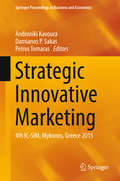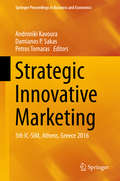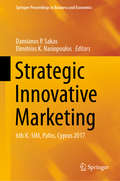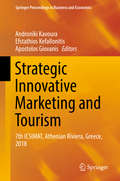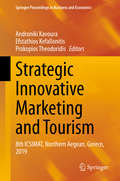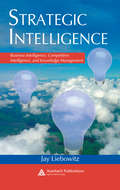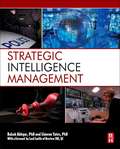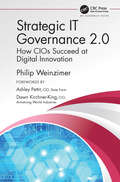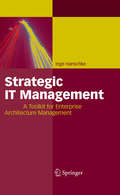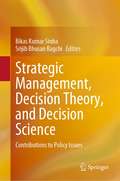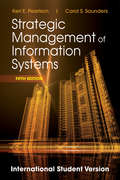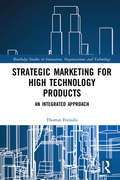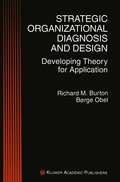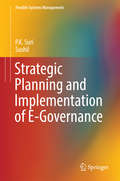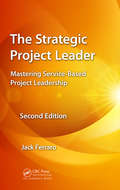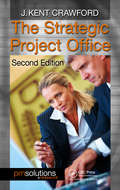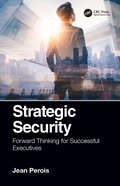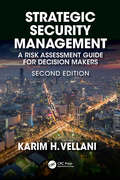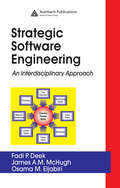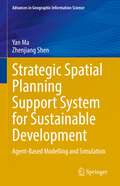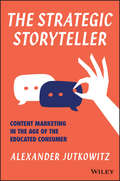- Table View
- List View
Strategic Innovative Marketing: 4th IC-SIM, Mykonos, Greece 2015 (Springer Proceedings in Business and Economics)
by Androniki Kavoura Damianos P. Sakas Petros TomarasThis book presents the latest on the theoretical approach of the contemporary issues evolved in strategic marketing and the integration of theory and practice. It seeks to make advancements in the discipline by promoting strategic research and innovative activities in marketing. The book highlights the use of data analytics, intelligence and knowledge-based systems in this area. In the era of knowledge-based economy, marketing has a lot to gain from collecting and analyzing data associated with customers, business processes, market economics or even data related to social activities. The contributed chapters are concerned with using modern qualitative and quantitative techniques based on information technology used to manage and analyze business data, to discover hidden knowledge and to introduce intelligence into marketing processes. This allows for a focus on innovative applications in all aspects of marketing, of computerized technologies related to data analytics, predictive analytics and modeling, business intelligence and knowledge engineering, in order to demonstrate new ways of uncovering hidden knowledge and supporting marketing decisions with evidence-based intelligent tools. Among the topics covered include innovative tourism marketing strategies, marketing communications in small and medium-sized enterprises (SMEs), the use of business modeling, as well as reflecting on the marketing trends and outlook for all transportation industry segments. The papers in this proceedings has been written by scientists, researchers, practitioners and students that demonstrate a special orientation in strategic marketing, all of whom aspire to be ahead of the curve based on the pillars of innovation. This proceedings volume compiles their contributions to the field, highlighting the exchange of insights on strategic issues in the science of innovation marketing.
Strategic Innovative Marketing: 5th IC-SIM, Athens, Greece 2016 (Springer Proceedings in Business and Economics)
by Androniki Kavoura Damianos P. Sakas Petros TomarasThis proceedings volume presents the latest on the theoretical approach of the contemporary issues evolved in strategic marketing and the integration of theory and practice. It highlights strategic research and innovative activities in marketing. The contributed chapters are concerned with using modern qualitative and quantitative techniques based on information technology used to manage and analyze business data, to discover hidden knowledge and to introduce intelligence into marketing processes. This allows for a focus on innovative applications in all aspects of marketing, of computerized technologies related to data analytics, predictive analytics and modeling, business intelligence and knowledge engineering, in order to demonstrate new ways of uncovering hidden knowledge and supporting marketing decisions with evidence-based intelligent tools. The chapters from the proceedings of the 5th International Conference on Strategic Innovative Marketing 2016 cover areas such as social media marketing innovation, sustainable marketing, customer satisfaction strategies, customer relationship management, marketing research and analytics. The papers have been written by scientists, researchers, practitioners and students that demonstrate a special orientation in strategic marketing, all of whom aspire to be ahead of the curve based on the pillars of innovation. This proceedings volume shares their recent contributions to the field and showcases their exchange of insights on strategic issues in the science of innovation marketing.
Strategic Innovative Marketing: 6th IC-SIM, Pafos, Cyprus 2017 (Springer Proceedings in Business and Economics)
by Damianos Sakas Dimitrios NasiopoulosThis proceedings volume highlights cutting-edge approaches for contemporary issues evolved in strategic marketing and the integration of theory and practice. It focuses on strategic research and innovative activities in marketing that can be used in everyday operations. The contributions have been divided into eight sections, grouping emerging marketing technologies together in a close examination of practices, problems and trends. The first section examines management challenges which influence societies, cultures, networks, organizations, teams, and individuals. It emphasizes ways business processes foster innovation and facilitate management transitions from dominant structures to more evolutionary, developmental paradigms. The second section discusses the benefits and guidelines to implementation of green marketing strategies. The following section pursues new perspectives of the role of location in marketing and its impact on consumer well-being. The next section explores the impacts of user generated content (UGC) on marketing theories and practice, which is followed by a section identifying how market-based assets can contribute to a sustainable competitive advantage. The sixth section covers understanding consumer perception to make marketing decisions. The final sections promote the use of business informatics and modeling in marketing and also the development of integrating information management in ways that change how people use information to engage in knowledge focused activities. The papers from the proceedings of the 6th International Conference on Strategic Innovative Marketing (IC-SIM 2017) have been written by scientists, researchers, practitioners and students that demonstrate a special orientation in strategic marketing, all of whom aspire to be ahead of the curve based on the pillars of innovation. This proceedings volume shares their recent contributions to the field and showcases their exchange of insights on strategic issues in the science of innovation marketing.
Strategic Innovative Marketing and Tourism: 7th ICSIMAT, Athenian Riviera, Greece, 2018 (Springer Proceedings in Business and Economics)
by Androniki Kavoura Efstathios Kefallonitis Apostolos GiovanisThis book covers a very broad range of topics in marketing, communication, and tourism, focusing especially on new perspectives and technologies that promise to influence the future direction of marketing research and practice in a digital and innovational era. Among the areas covered are product and brand management, strategic marketing, B2B marketing and sales management, international marketing, business communication and advertising, digital and social marketing, tourism and hospitality marketing and management, destination branding and cultural management, and event marketing. The book comprises the proceedings of the International Conference on Strategic Innovative Marketing and Tourism (ICSIMAT) 2018, where researchers, academics, and government and industry practitioners from around the world came together to discuss best practices, the latest research, new paradigms, and advances in theory. It will be of interest to a wide audience, including members of the academic community, MSc and PhD students, and marketing and tourism professionals.
Strategic Innovative Marketing and Tourism: 8th ICSIMAT, Northern Aegean, Greece, 2019 (Springer Proceedings in Business and Economics)
by Androniki Kavoura Efstathios Kefallonitis Prokopios TheodoridisThis book covers a very broad range of topics in marketing, communication, and tourism, focusing especially on new perspectives and technologies that promise to influence the future direction of marketing research and practice in a digital and innovational era. Among the areas covered are product and brand management, strategic marketing, B2B marketing and sales management, international marketing, business communication and advertising, digital and social marketing, tourism and hospitality marketing and management, destination branding and cultural management, and event marketing. The book comprises the proceedings of the International Conference on Strategic Innovative Marketing and Tourism (ICSIMAT) 2019, where researchers, academics, and government and industry practitioners from around the world came together to discuss best practices, the latest research, new paradigms, and advances in theory. It will be of interest to a wide audience, including members of the academic community, MSc and PhD students, and marketing and tourism professionals.
Strategic Intelligence: Business Intelligence, Competitive Intelligence, and Knowledge Management
by Jay LiebowitzStrategic intelligence (SI) has mostly been used in military settings, but its worth goes well beyond that limited role. It has become invaluable for improving any organization's strategic decision making process. The author of Strategic Intelligence: Business Intelligence, Competitive Intelligence, and Knowledge Management recognizes synergies amo
Strategic Intelligence Management: National Security Imperatives and Information and Communications Technologies
by Babak Akhgar Simeon YatesStrategic Intelligence Management introduces both academic researchers and law enforcement professionals to contemporary issues of national security and information management and analysis. This contributed volume draws on state-of-the-art expertise from academics and law enforcement practitioners across the globe. The chapter authors provide background, analysis, and insight on specific topics and case studies. Strategic Intelligent Management explores the technological and social aspects of managing information for contemporary national security imperatives. Academic researchers and graduate students in computer science, information studies, social science, law, terrorism studies, and politics, as well as professionals in the police, law enforcement, security agencies, and government policy organizations will welcome this authoritative and wide-ranging discussion of emerging threats.Hot topics like cyber terrorism, Big Data, and Somali pirates, addressed in terms the layperson can understand, with solid research groundingFills a gap in existing literature on intelligence, technology, and national security
Strategic IT Governance 2.0: How CIOs Succeed at Digital Innovation
by Philip WeinzimerWeinzimer provides industry case studies of companies that have implemented multiple components of The Strategic IT Governance 2.0 model. These companies successfully leveraged collaboration between technology and the business to deliver technology projects that provide the best customer value, improve cost efficiencies, and create a governance culture across business areas. In his book, you will learn valuable lessons to implement an innovative governance model for your company.— Ashley Pettit, CIO, and Senior Vice President, Enterprise Technology, State Farm In Strategic IT Governance 2.0, Phil provides a number of exciting case studies of how CIOs are leveraging technology to innovate and create value. They are following Phil's model, building strategic and tactical relationships within the business to drive technology growth strategies, collaborating with partners to improve customer service and increase value with process optimization and best practice metrics. Each of these companies offers a slightly different take on the multiple components of the Strategic IT Governance 2.0 model; however, these organizations' collective and individual success indicates the strength of the components.— Dawn Kirchner-King, Vice President and Chief Information Officer, Armstrong World Industries Today's business environment is more complicated, creating additional challenges for the successful execution of strategic enterprise projects. Unless an organization revisits its governance model, strategic projects are at risk of negatively impacting business success. So, how do companies succeed in overcoming these obstacles to improve project success? Strategic IT Governance 2.0: How CIOs Succeed at Digital Innovation explains how IT executives can take the lead and successfully drive digital transformation initiatives and associated projects. The book presents the Strategic IT Governance 2.0 model that focuses on project alignment, process reinvention, and leadership excellence. It is filled with case studies of the model’s implementation, giving practical insight into how organizations have successfully executed digital transformation.
Strategic IT Governance 2.0: How CIOs Succeed at Digital Innovation
by Philip WeinzimerWeinzimer provides industry case studies of companies that have implemented multiple components of The Strategic IT Governance 2.0 model. These companies successfully leveraged collaboration between technology and the business to deliver technology projects that provide the best customer value, improve cost efficiencies, and create a governance culture across business areas. In his book, you will learn valuable lessons to implement an innovative governance model for your company.— Ashley Pettit, CIO, and Senior Vice President, Enterprise Technology, State Farm In Strategic IT Governance 2.0, Phil provides a number of exciting case studies of how CIOs are leveraging technology to innovate and create value. They are following Phil's model, building strategic and tactical relationships within the business to drive technology growth strategies, collaborating with partners to improve customer service and increase value with process optimization and best practice metrics. Each of these companies offers a slightly different take on the multiple components of the Strategic IT Governance 2.0 model; however, these organizations' collective and individual success indicates the strength of the components.— Dawn Kirchner-King, Vice President and Chief Information Officer, Armstrong World Industries Today's business environment is more complicated, creating additional challenges for the successful execution of strategic enterprise projects. Unless an organization revisits its governance model, strategic projects are at risk of negatively impacting business success. So, how do companies succeed in overcoming these obstacles to improve project success? Strategic IT Governance 2.0: How CIOs Succeed at Digital Innovation explains how IT executives can take the lead and successfully drive digital transformation initiatives and associated projects. The book presents the Strategic IT Governance 2.0 model that focuses on project alignment, process reinvention, and leadership excellence. It is filled with case studies of the model’s implementation, giving practical insight into how organizations have successfully executed digital transformation.
Strategic IT Management: A Toolkit for Enterprise Architecture Management
by Inge HanschkeFor you as an IT manager, changes in business models and fast-paced innovation and product lifecycles pose a big challenge: you are required to anticipate the impact of future changes, and to make rapid decisions backed up by solid facts. To be successful you need an overall perspective of how business and IT interact. What you need is a toolkit, enabling you to manage the enterprise from a helicopter viewpoint while at the same time accommodating quite detailed aspects of processes, organization, and software lifecycles. Strategic IT management embraces all the processes required to analyze and document an enterprise’s IT landscape. Based on the experience of many projects and long discussions with both customers and academic researchers, Inge Hanschke provides you with a comprehensive and practical toolkit for the strategic management of your IT landscape. She takes a holistic view on the management process and gives guidelines on how to establish, roll out, and maintain an enterprise IT landscape effectively. She shows you how to do it right first time – because often enough there’s no second chance. She tells you how to tidy up a IT patchworks – the first step towards strategic management – and she gives you advice on how to implement changes and maintain the landscape over time. The book’s structure reflects the patterns that exist in strategic IT management from strategic planning to actual implementation. The presentation uses many checklists, guidelines, and illustrations, which will help you to immediately apply the content. So, if you are a CIO, an IT manager, a business manager, or an IT consultant, this is the book from which you’ll benefit in most daily work situations.
Strategic Management, Decision Theory, and Decision Science: Contributions to Policy Issues
by Bikas Kumar Sinha Srijib Bhusan BagchiThis book contains international perspectives that unifies the themes of strategic management, decision theory, and data science. It contains thought-provoking presentations of case studies backed by adequate analysis adding significance to the discussions. Most of the decision-making models in use do take due advantage of collection and processing of relevant data using appropriate analytics oriented to provide inputs into effective decision-making. The book showcases applications in diverse fields including banking and insurance, portfolio management, inventory analysis, performance assessment of comparable economic agents, managing utilities in a health-care facility, reducing traffic snarls on highways, monitoring achievement of some of the sustainable development goals in a country or state, and similar other areas that showcase policy implications. It holds immense value for researchers as well as professionals responsible for organizational decisions.
Strategic Management of Information Systems
by Keri E. Pearlson Carol S. SaundersThis brief, but complete, paperback builds a basic framework for the relationships among business strategy, information systems, and organizational strategies. Readers will learn how IT relate to organizational design and business strategy, how to recognize opportunities in the work environment, and how to apply current technologies in innovative ways.
Strategic Marketing for High Technology Products: An Integrated Approach (Routledge Studies in Innovation, Organizations and Technology)
by Thomas FotiadisIn order for High Technology (HT) companies to tackle contemporary demanding market challenges, they frequently deploy time-reduction strategies with respect to product launch. Marketing of technology related products – and especially cutting edge ones – involves a complex and multidimensional bundle of specific and unique characteristics, such as the complexity of products, the intensity of the competition, confusion and/ or fear of adoption among consumers, fast pacing changes in the external environment. The very nature of the interrelations that evolve as part of the dynamic process of strategy formulation contributes further to the formulation of a very challenging environment which is described as tumultuous, volatile and turbulent. These specific features, qualities and characteristics constitute the core of the innate need for an integrated approach that requires and depends on the cooperation and coordination of specific functional competencies. This book employs a systemic approach that accommodates the integration of specialized departmental capabilities as a fundamental prerequisite and a cornerstone for the successful navigation of high-tech organizations in their extremely competitive environments. It provides a solid and extant context of compact and consistent cognitive background that is specific to the HT strategic marketing field, and a strategic tool that utilizes, relies and is built on the turbulent environment of HT rather than just overlooking, avoiding or ignoring it, and that assumes a proactive point of view, capitalizing on characteristics specific to this field, through the provision of a strategic managerial and marketing model that is overlaid onto a reliably assessed foundation of dynamic qualities, with a long-term orientation and scope, albeit one that would be easy to apply and which will generate immediate results.
Strategic Marketing for High Technology Products: An Integrated Approach (Routledge Studies in Innovation, Organizations and Technology)
by Thomas FotiadisIn order for High Technology (HT) companies to tackle contemporary demanding market challenges, they frequently deploy time-reduction strategies with respect to product launch. Marketing of technology related products – and especially cutting edge ones – involves a complex and multidimensional bundle of specific and unique characteristics, such as the complexity of products, the intensity of the competition, confusion and/ or fear of adoption among consumers, fast pacing changes in the external environment. The very nature of the interrelations that evolve as part of the dynamic process of strategy formulation contributes further to the formulation of a very challenging environment which is described as tumultuous, volatile and turbulent. These specific features, qualities and characteristics constitute the core of the innate need for an integrated approach that requires and depends on the cooperation and coordination of specific functional competencies. This book employs a systemic approach that accommodates the integration of specialized departmental capabilities as a fundamental prerequisite and a cornerstone for the successful navigation of high-tech organizations in their extremely competitive environments. It provides a solid and extant context of compact and consistent cognitive background that is specific to the HT strategic marketing field, and a strategic tool that utilizes, relies and is built on the turbulent environment of HT rather than just overlooking, avoiding or ignoring it, and that assumes a proactive point of view, capitalizing on characteristics specific to this field, through the provision of a strategic managerial and marketing model that is overlaid onto a reliably assessed foundation of dynamic qualities, with a long-term orientation and scope, albeit one that would be easy to apply and which will generate immediate results.
Strategic Organizational Diagnosis and Design: Developing Theory for Application (Information and Organization Design Series #4)
by Richard M. Burton Borge ObelA unique set of complementary hands-on tools for learning about and applying a deeper and practical theory for diagnosis and design. This edition has been significantly updated and rewritten to make it easier to read.
Strategic Planning and Implementation of E-Governance (Flexible Systems Management)
by P. K. Suri SushilThe book is based on practical experience gained during the planning and execution of e-governance projects in India coupled with extensive research based on six national/multi-state-level agriculture related projects. It assesses e-governance projects in terms of desired project outcomes and analyzes performance from the viewpoints of three key groups – planners, implementers and beneficiaries. It highlights six constructs: extent of planning, comprehensiveness of strategy formulation, effectiveness of strategy implementation, changing situation, stakeholder competence levels and flexibility of processes, which are applied to reveal shortfalls in the existing planning and implementation system for e-governance projects in India. It also identifies a set of significant strategic variables influencing performance based on three independent opinion surveys of stakeholders located across the country, and uses these variables as the basis of strategic gap analyses of some major ongoing agriculture related projects. Furthermore it presents lessons learned from cross-case quantitative and qualitative analyses in the form of a generalized strategic framework for improving performance. Offering an overview of major e-governance projects, it uses several illustrative examples to address the underlying issues and to support the study findings and recommendations. It also presents a novel approach of building strategic alliances across related departments to achieve effective e-governance. The book will be of interest to the practitioners in government as well corporates who are engaged in planning and implementation of e-governance projects spanning across various layers of government. In Indian context, the learning issues are likely to trigger appropriate corrective measures for generating better value from the several flagship projects envisaged under the Digital India Programme. Further, it will interest the academic audience working on the strategic framework and constituting constructs. It will also benefit business students and application software architectures who aspire for a consulting career in the area of e-governance.
The Strategic Project Leader: Mastering Service-Based Project Leadership, Second Edition
by Jack FerraroAs executives build and nurture their organization's strategic agility in today's turbulent, uncertain business environment, the ability to lead strategic change has become more critical than ever. The Strategic Project Leader: Mastering Service-Based Project Leadership, Second Edition will help project managers lead with confidence in temporary, a
The Strategic Project Office
by J. Kent CrawfordThe second edition of this award-winning reference provides step-by-step instructions for establishing and maturing a project management office (PMO). Concise and easy to read, The Strategic Project Office, Second Edition covers the four primary areas of knowledge and practice regarding the PMO: governance and portfolio management, resource optimiz
Strategic Security: Forward Thinking for Successful Executives
by Jean PeroisStrategic Security will help security managers, and those aspiring to the position, to think strategically about their job, the culture of their workplace, and the nature of security planning and implementation. Security professionals tend to focus on the immediate (the urgent) rather than the important and essential—too often serving as "firefighters" rather than strategists. This book will help professionals consider their roles, and structure their tasks through a strategic approach without neglecting their career objectives. Few security management books for professionals in the field focus on corporate or industrial security from a strategic perspective. Books on the market normally provide "recipes," methods or guidelines to develop, plans, policies or procedures. However, many do so without taking into account the personal element that is supposed to apply these methods. In this book, the authors helps readers to consider their own career development in parallel with establishing their organisation security programme. This is fundamental to becoming, and serving as, a quality, effective manager. The element of considering career objectives as part-and-parcel to this is both unique to only this book and vital for long-term career success. The author delineates what makes strategic thinking different in a corporate and security environment. While strategy is crucial in the running of a company, the traditional attitude towards security is that it has to fix issues quickly and at low cost. This is an attitude that no other department would tolerate, but because of its image, security departments sometimes have major issues with buy-in and from top-management. The book covers the necessary level of strategic thinking to put their ideas into practice. Once this is achieved, the strategic process is explained, including the need to build the different steps into this process—and into the overarching business goals of the organisation—will be demonstrated. The book provides numerous hand-on examples of how to formulate and execute the strategic master plan for the organization. The authors draws on his extensive experience and successes to serve as a valuable resource to all security professionals looking to advance their careers in the field.
Strategic Security: Forward Thinking for Successful Executives
by Jean PeroisStrategic Security will help security managers, and those aspiring to the position, to think strategically about their job, the culture of their workplace, and the nature of security planning and implementation. Security professionals tend to focus on the immediate (the urgent) rather than the important and essential—too often serving as "firefighters" rather than strategists. This book will help professionals consider their roles, and structure their tasks through a strategic approach without neglecting their career objectives. Few security management books for professionals in the field focus on corporate or industrial security from a strategic perspective. Books on the market normally provide "recipes," methods or guidelines to develop, plans, policies or procedures. However, many do so without taking into account the personal element that is supposed to apply these methods. In this book, the authors helps readers to consider their own career development in parallel with establishing their organisation security programme. This is fundamental to becoming, and serving as, a quality, effective manager. The element of considering career objectives as part-and-parcel to this is both unique to only this book and vital for long-term career success. The author delineates what makes strategic thinking different in a corporate and security environment. While strategy is crucial in the running of a company, the traditional attitude towards security is that it has to fix issues quickly and at low cost. This is an attitude that no other department would tolerate, but because of its image, security departments sometimes have major issues with buy-in and from top-management. The book covers the necessary level of strategic thinking to put their ideas into practice. Once this is achieved, the strategic process is explained, including the need to build the different steps into this process—and into the overarching business goals of the organisation—will be demonstrated. The book provides numerous hand-on examples of how to formulate and execute the strategic master plan for the organization. The authors draws on his extensive experience and successes to serve as a valuable resource to all security professionals looking to advance their careers in the field.
Strategic Security Management: A Risk Assessment Guide for Decision Makers, Second Edition
by Karim VellaniStrategic Security Management, Second Edition provides security leadership and decision-makers with a fresh perspective on threat, vulnerability, and risk assessment. The book offers a framework to look at applying security analysis and theory into practice for effective security program, implementation, management and evaluation. Chapters examine metric-based security resource allocation of countermeasures, including security procedures, utilization of personnel, and electronic measures. The new edition is fully updated to reflect the latest industry best-practices and includes contributions from security industry leaders—based on their years of professional experience—including: Nick Vellani, Michael Silva, Kenneth Wheatley, Robert Emery, Michael Haggard. Strategic Security Management, Second Edition will be a welcome addition to the security literature for all security professionals, security managers, and criminal justice students interested in understanding foundational security principles and their application.
Strategic Security Management: A Risk Assessment Guide for Decision Makers, Second Edition
by Karim VellaniStrategic Security Management, Second Edition provides security leadership and decision-makers with a fresh perspective on threat, vulnerability, and risk assessment. The book offers a framework to look at applying security analysis and theory into practice for effective security program, implementation, management and evaluation. Chapters examine metric-based security resource allocation of countermeasures, including security procedures, utilization of personnel, and electronic measures. The new edition is fully updated to reflect the latest industry best-practices and includes contributions from security industry leaders—based on their years of professional experience—including: Nick Vellani, Michael Silva, Kenneth Wheatley, Robert Emery, Michael Haggard. Strategic Security Management, Second Edition will be a welcome addition to the security literature for all security professionals, security managers, and criminal justice students interested in understanding foundational security principles and their application.
Strategic Software Engineering: An Interdisciplinary Approach
by Fadi P. Deek James A. McHugh Osama M. EljabiriThe pervasiveness of software in business makes it crucial that software engineers and developers understand how software development impacts an entire organization. Strategic Software Engineering: An Interdisciplinary Approach presents software engineering as a strategic, business-oriented, interdisciplinary endeavor, rather than simply a technica
Strategic Spatial Planning Support System for Sustainable Development: Agent-Based Modelling and Simulation (Advances in Geographic Information Science)
by Yan Ma Zhenjiang ShenThis book introduces a planning support system called Strategic Spatial Plan Support System (SSP-SS) to visualize population growth and predict energy demand, land use, and waste discharge resulting from urbanization. By analyzing policy interactions between household agents, the book uses SSP-SS to visualize policy effects on urban areas during stages of growth and decline. Simulations are created based on these policy outcome assessments, taking into account the influences of energy and resource consumption on sustainable development in urban environments. The book is geared towards researchers, universities, and urban policy makers.The book begins by presenting a framework of urban growth simulation, and introducing SSP-SS. Then, household lifecycle and relocation models are employed for simulating policy impacts on urbanization, and investigating the impacts of spatial strategic planning. Several projects are assessed using agent-based modeling including shopping centre construction, day-care service for aging populations, and shelter accommodation capacities for earthquakes and other disasters. The final chapters discuss water and energy management, the environmental impacts of demand and consumption, and future recommendations for sustainable development and policy implementation.Introduces Strategic Spatial Plan Support System (SSP-SS) to visualize population growth and predict energy demand, land use, and waste discharge resulting from urbanization.Analyzes policy effects on urban areas during stages of growth and decline.Discusses the influences of water and gas consumption on environmental issues in urban areas for sustainable development.
The Strategic Storyteller: Content Marketing in the Age of the Educated Consumer
by Alexander JutkowitzThe world needs more storytellers. Storytelling is an inherently innovative activity. When organizations find their best stories and tell them to the world, they’re not only building a reputation, they're flexing the same muscles that allow them to pivot quickly around crisis or opportunity, and solve problems more creatively. For individuals, crafting stories is the primary way we can make sense of the world and our place in it. The Strategic Storyteller is a comprehensive, practical guide to transformative storytelling. In its pages you will learn how to: Tap into your and your organization's unique sources of wonder, wisdom, and delight Boost individual and collective creativity Understand the storytelling strategies behind some of the world’s most powerful brands Unlock the secrets of the great strategic storytellers of the past Build a place where your stories can live online Distribute stories so they have staying power and reach in the digital age Convene audiences by going beyond demographic stereotypes and tapping into enduring human needs Understand how unshakable reputations are built out of stories that accumulate over time Sooner or later all of us will be asked to tell stories in the course of our professional lives. We will be asked to make a case for ourselves, our work, our companies, and our future. The Strategic Storyteller tells you how.
